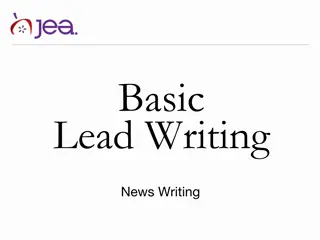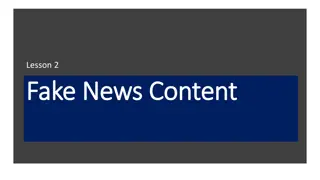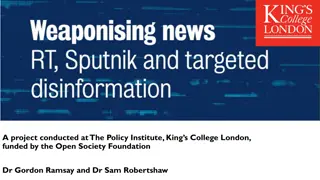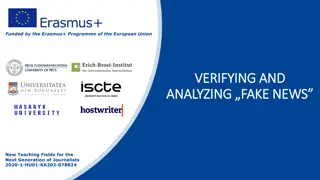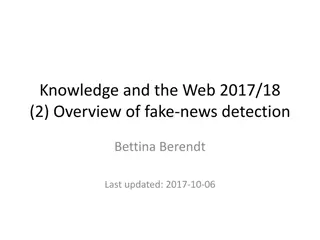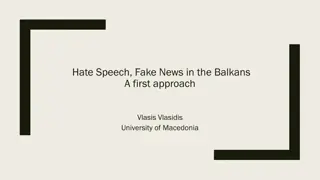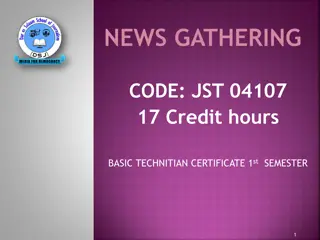
Formulation of Indian Standards and Non-Destructive Testing Overview
Learn about the stages involved in the formulation of Indian standards, including the identification of needs, proposal stage, preparatory stage, committee stage, public comment stage, approval stage, and publication stage. Also, gain insights into non-destructive testing practices and their importance in quality assurance.
Download Presentation

Please find below an Image/Link to download the presentation.
The content on the website is provided AS IS for your information and personal use only. It may not be sold, licensed, or shared on other websites without obtaining consent from the author. If you encounter any issues during the download, it is possible that the publisher has removed the file from their server.
You are allowed to download the files provided on this website for personal or commercial use, subject to the condition that they are used lawfully. All files are the property of their respective owners.
The content on the website is provided AS IS for your information and personal use only. It may not be sold, licensed, or shared on other websites without obtaining consent from the author.
E N D
Presentation Transcript
1 Non - Destructive Testing Kunal Kumar Scientist-E Metallurgical Engineering Department Bureau of Indian Standards www.bis.gov.in
Standard 2 A standard is a document, established by consensus and approved by a recognized body, that provides, for common and repeated use, rules, guidelines or characteristics for activities or their results, aimed at the achievement of the optimum degree of order in a given context (see ISO Guide 2). The process of standard development is based on the core principle of Openness, transparency, impartiality and consensus. Standard can be a product specification, a code of practice, a terminology standard, a process specification, a service specification, a test method, system specification, dimensions, etc. (see ISO/IEC Guide 2). NOTE Standards should be based on the consolidated results of science, technology and experience, and aimed at the promotion of optimum community benefits. A Standard is a document setting out good practices established by consensus subject to public consultation and approved by a national committee.
Stages of Formulation of Indian Standards 3 1. Identification of Need: Stakeholder Input: Industry, government, consumers, and other stakeholders identify the need for a new standard or revision of an existing one. Market Demand: Emerging technologies, market requirements, or regulatory changes may drive the need for new standards. 2. Proposal Stage: New Work Item Proposal (NWIP): A proposal for a new standard or revision is submitted to the Bureau of Indian Standards (BIS). Approval: The relevant technical committee reviews and approves the proposal for further action. 3. Preparatory Stage: Working Group Formation: A working group of experts is formed to draft the standard. Initial Draft: The working group prepares the initial draft of the standard based on research, existing international/national standards, and expert input.
Stages of Formulation of Indian Standards 4 4. Committee Stage: Technical Committee Review: The draft standard is reviewed by the relevant technical committee, which includes representatives from industry, government, academia, and other stakeholders. Comments and Revisions: Feedback is collected, and the draft is revised accordingly to address comments and suggestions. 5. Public Comment Stage: Public Circulation: The draft standard is circulated for public comments, allowing a wider range of stakeholders to provide input. Feedback Collection: Comments from the public are collected, reviewed, and incorporated into the draft as necessary. 6. Finalization Stage: Technical Committee Approval: The revised draft, incorporating public comments, is reviewed and approved by the technical committee. Draft Indian Standard (DIS): The final draft is prepared and submitted for formal approval.
Stages of Formulation of Indian Standards 5 7. Approval Stage: Sectional Committee Approval: The sectional committee approves the final draft standard. BIS Council Approval: The BIS Council, which oversees the activities of BIS, gives final approval for the standard. 8. Publication Stage: Notification: The approved standard is notified and published by BIS. Availability: The new or revised standard is made available to the public and stakeholders through BIS publications and online portals. 9. Review and Revision: Periodic Review: Standards are periodically reviewed to ensure they remain relevant and up-to-date. Amendments and Revisions: Based on the review, standards may be amended or revised to reflect technological advancements, regulatory changes, and industry needs.
What is NDT? Non-destructive testing (NDT) is a wide group of analysis techniques used in science and technology industry to evaluate the properties of a material, component or system without causing damage. The terms nondestructive examination (NDE), nondestructive inspection (NDI), and nondestructive evaluation (NDE) are also commonly used to describe this technology.
Why NDT ? Because NDT does not permanently alter the article being inspected, it is a highly valuable technique that can save both money and time in product evaluation, troubleshooting, and research. - NDT does not directly measure mechanical properties but they are used to locate defects or flaws in the component. - Flaws reduce useful life of component resulting in premature failure even with a sound design and proper selection of materials. - To obtain high level of reliability , defect should be absent or at minimum level. - NDT is carried out periodically. - Replacement of component before its premature failure to avoid dangerous results.
Application of NDT NDT is commonly used in Aerospace: Inspecting aircraft components for fatigue cracks and corrosion. Automotive: Ensuring the integrity of engine parts and chassis components. Construction: Evaluating the quality of welds and concrete structures. Manufacturing: Verifying the quality of raw materials and finished products. Innovations in the field of nondestructive testing have had a profound impact on medical imaging, including on echocardiography, medical ultrasonography, and digital radiography.
Need for Standards on Various NDT Methods 1. Consistency and Uniformity 9 Standardized Procedures: Standards provide detailed guidelines on how to perform specific NDT methods, ensuring that the procedures are carried out uniformly across different operators and organizations. Repeatability: Consistent application of NDT methods ensures that results are repeatable and reliable, regardless of who performs the test. 2. Quality Assurance Verification of Integrity: Standards help verify the integrity and quality of materials and components, ensuring they meet specified criteria and performance requirements. Defect Detection: Established standards ensure that NDT methods are capable of detecting defects of a specified size and nature, thus ensuring the safety and reliability of the tested components. 3. Safety Preventing Failures: By adhering to standardized NDT procedures, potential failures and defects can be identified and addressed before they lead to accidents or catastrophic events. Worker Safety: Standards often include safety protocols to protect NDT personnel from hazards associated with the testing methods.
Need for Standards on Various NDT Methods 10 4. Compliance and Regulation Meeting Regulatory Requirements: Many industries are regulated by government bodies that require compliance with specific NDT standards to ensure safety and reliability. Legal Accountability: Adherence to standards can provide legal protection and accountability in case of disputes or failures. 5. Training and Certification Competency of Personnel: Standards often include requirements for the qualification and certification of NDT personnel, ensuring that individuals performing the tests are competent and adequately trained. Consistent Training Programs: Standardized training programs based on established standards ensure that all NDT personnel receive consistent and comprehensive training. 6. Interchangeability Cross-Industry Applicability: Standardized NDT methods allow for the interchangeability of components and materials across different industries, facilitating broader use and application. Compatibility: Ensuring that NDT results are compatible and comparable across different projects and sectors.
Need for Standards on Various NDT Methods 11 7. Economic Efficiency Reducing Waste: Standards help minimize material waste by ensuring accurate detection of defects and preventing unnecessary rejection of materials. Cost-Effective Maintenance: Standardized NDT methods enable cost- effective maintenance strategies by identifying defects early and reducing the need for costly repairs or replacements. 8. Global Trade International Acceptance: International standards (e.g., ISO, ASTM) facilitate global trade by ensuring that products meet universally recognized quality and safety criteria. Harmonization: Standardized NDT methods promote harmonization of practices across different countries, reducing trade barriers and fostering international cooperation.
12 MTD 21 Non-Destructive Testing Sectional Committee Scope : Standardization in the field of Non-Destructive Testing . This committee has formulated 68 standards. List of the standards can be seen www.standardsbis.in. Some of the important standards are detailed in next slides. and downloaded from
Different NDT Methods 1. LIQUID DYE PENETRATION TEST 2. MAGNETIC PARTICLE TEST 3. ULTRASONIC TEST 4. RADIOGRAPHY TEST 5. EDDY CURRENT TEST 6. VISUAL INSPECTION 7. ACOUSTIC EMISSION TESTING 8. LEAK TESTING 9. THERMOGRAPHIC TESTING
14 INDIAN STANDARDS ON NON-DESTRUCTIVE TESTING Liquid Dye Penetration Test IS 3658 : 1999 Code of practice for liquid penetrant flaw detection IS 12889 : 2018 ISO 3452-2:2013 Performance evaluation of materials used for liquid penetrant test (First Revision) Magnetic Particle Test IS 3703 : 2023 Recommended practice for magnetic particle flaw detection IS 10543 : 1983 ISO 9934-1:2016 - Method for dry powder magnetic particle testing IS 12147 : 2013 Recommended practice for wet magnetic particle examination
15 INDIAN STANDARDS ON NON-DESTRUCTIVE TESTING Ultrasonic Test IS 3664 : 1981 ISO 18175 ISO 2400 ISO 7963 Code of practice for ultrasonic pulse echo testing by contact and immersion methods (first revision) IS 12666 : 2018 ISO 16831:2012 Performance assessment of ultrasonic flaw detection equipment (First Revision) Radiography Test IS 1182 : 1983 Recommended - Practice for radiographic examination of fusion welded butt joints in steel plates (Second Revision) IS 2595 : 2008 Industrial radiographic testing - Code of practice (Second Revision) New Standard Micro focal Radiography of Industrial components NWIP proposed in ISO - Evaluation of the Integrity of Various Shielding Structures by Using Gammatography Technique
16 INDIAN STANDARDS ON NON-DESTRUCTIVE TESTING Eddy Current Test IS 11612 : 2004 Code of practice for eddy current testing of non-ferrous seamless pipes and tubes (First Revision) IS 12965 : 1990 ISO 12718:2008 Glossary of terms used in electro magnetic (Eddy Current) testing IS 13190 : 1991 ISO 15548-2:2013 Recommended practice for eddy current examination by rotating probe method of round steel bars Visual Examination IS 16979 : 2018 Guidelines for visual inspection using bore scopes and video scopes
17 INDIAN STANDARDS ON NON-DESTRUCTIVE TESTING Acoustic Emission Testing IS 12710 : 1989 ISO 12716 Acoustic emission testing - Glossary of terms IS 14670 : 1999 Recommended practice for acoustic emission inspection during hydrostatic pressure testing of system Leak Testing IS 8973 : 1991 ISO 20484:2017 Leak detection techniques glossary (First Revision) IS 9902 : 2004 Recommended practice for leak testing (First Revision)
18 1 IS 3658 : 1999 Code of practice for liquid penetrant flaw detection
Structure of Standard (IS 3658 : 1999) 1. Scope 2. References 3. Terminology 4. Principle of test 5. Materials 6. Procedure 7. Dwell Time 8. Lighting condition 9. Interpretation of result 10. Post cleaning 11. Report of Examination
IS 3658 : 1999- Code of practice for liquid penetrant flaw detection 20 Important term and definitions 11. Comparative test block 12. Contaminant 13. Contact time 14. Developing time 15. Drain time 16. Dwell time 17. Penetration time 18. Indication 19. Inspection 20. Interpretation 1. Penetrant 2. Developer 3. Cleaner 4. Aerosol spreying 5. Air accelerated spraying 6. Background 7. Bleed- out 8. Blotting 9. Capillary action 10.Clean test piece
IS 3658 : 1999- Code of practice for liquid penetrant flaw detection 21 Principle A suitable liquid penetrant is applied to the surface of the component under examination and is permitted to remain there for sufficient time to allow the liquid to penetrant into any defects open at the surface. After the penetrant time, the excess penetrant, which remain on the surface, is removed. Then a light coloured, powder absorbent called a developer is applied to the surface. This developer acts as a blotter and draws out a portion of the penetrant which had previously seeped into the surface openings. As the penetrant is drawn out, it diffuses into the coating of the developer, forming indications of the surface discontinuities or flaws (see fig).
IS 3658 : 1999- Code of practice for liquid penetrant flaw detection 22 Procedure 1. Cleaning of surface.(Grease, oil, any other material). 2. Drying of surface. 3. Applying dye-penetrant on clean and dry surface. It is allowed to penetrate in surface flaws. 4. Removing excess penetrant by soft or clean cotton. 5. Applying developer on surface. This pulls out dye from flaws and flaws are revealed by colour of dye.
IS 3658 : 1999- Code of practice for liquid penetrant flaw detection 25 Testing report The results of the liquid penetrant test shall be reported covering information on: a) Identification/Reference of construction and weld, b) testing media and cleaning operation, c) penetration and developing time, d) description and locations of relevant indications, e) deviations if any, adopted from the provisions of this Indian Standard, f) manufacturer s name/code of penetrant chemicals, and g) name of operator and competency level.
IS 3658 : 1999- Code of practice for liquid penetrant flaw detection 26 Specific difference Liquid penetrant testing with IS Code Liquid penetrant testing without IS Code Using IS 3658 for liquid penetrant testing ensures reliable, and reproducible process, which is crucial for detecting surface-breaking defects effectively. In contrast, conducting LPT without adhering to such standards may result in inconsistent and unreliable inspections, compromising the integrity of the tested materials or components. a consistent, potentially It helps maintain quality and safety in engineering applications.
Advantages and Disadvantages of Dye Penetrant Inspection Advantages Disadvantages This test can be applied to almost any type of metals, nonmetals, magnetic or non magnetic type. Simple to utilize and control. Cleaning of components is must before and after testing to avoid rusting Misleading results may be obtained in case of components with surface films and coatings Only surface defects can be detected Results of test can be interpreted fastly. Cost of test is very less as it does not require any instrument or electronic display units. Sensitivity is greater than that of magnetic particle testing. Test is not applicable for powder metallurgical components
28 2 IS 3703 : 2023 Recommended practice for magnetic particle flaw detection
IS 3703 : 2023- Recommended practice for Magnetic Particle flaw detection Terms & Definitions The definitions given in IS 3415 shall apply. Some important terms & definitions are mentioned - AC (Alternating Current)- Alternating Current (AC) is a type of electrical current that reverses direction periodically. The voltage (potential difference) of AC also varies in a sinusoidal waveform over time. DC (Direct Current)- Direct Current (DC) is a type of electrical current that flows in a single direction. The voltage in a DC circuit remains constant over time. Alternating Current Impulse - Alternating current of short duration. Alternating Current Magnetization - alternating current. Background - The area against which a flaw indication is sought after the application of magnetic particles. Background Paint - A paint applied to a surface prior to magnetic particle examination to increase contrast and thus to facilitate observation of an indication. Magnetization induced by an
IS 3703 : 2023- Recommended practice for Magnetic Particle flaw detection Terms & Definitions Carrier Fluid - The fluid in which magnetic particles are suspended to facilitate the application of the particles. Central Conductor - A conductor passed through a hollow part and used for producing circular magnetization. Circular Magnetization - which causes a flux to have directions parallel to the periphery of a component when current is passed along its longitudinal axis. Gauss - The old unit of magnetic field strength now replaced by the tesla, T. Gauss Meter - Equipment measuring magnetic field strength or intensity. Magnetic Field Leakage - The loss of magnetic field strength due to undesirable discontinuities and changes in section in a magnetic circuit.
IS 3703 : 2023- Recommended practice for Magnetic Particle flaw detection Terms & Definitions Leakage Flux - The magnetic flux that appears on the surface of the object due to the presence of a discontinuity. Longitudinal Magnetization - Magnetization where the flux lines of the field traverse in the component in a direction essentially parallel to its longitudinal axis. Magnetic Flux - It is the product of magnetic flux density and cross sectional area through which the flux lines pass. Magnetic Flux Density (B) - It is the total intensity of magnetization in a magnetized component consisting of the contribution due to the applied field and the induced intensity of magnetization. Demagnetization - The reduction in the intensity of residual magnetism in ferromagnetic materials to an acceptable level. Demagnetizing Coil - A coil of wire carrying alternating current which is used for demagnetization. Yoke - A magnet that induces a magnetic field in the area or a part that lies between its poles. Yokes may be permanent magnets or either alternating current or direct current electromagnets or half wave direct current.
IS 3703 : 2023- Recommended practice for Magnetic Particle flaw detection Principle of Test The magnetic particle method is based on the principle that magnetic lines of forces, when present in a ferromagnetic material will be distorted by a local change in the permeability due to the presence of any discontinuity having permeability different to that of the test piece. These distorted magnetic lines of forces result in leakage flux which leaps through air from one side of the discontinuity to the other side creating magnetic north and south poles at these points of exit and re-entry respectively. If finely divided ferromagnetic particles are applied to the surface of the test piece, they are attracted by these poles to form a pattern of the discontinuity.
IS 3703 : 2023- Recommended practice for Magnetic Particle flaw detection Test Procedure Surface preparation; Initial demagnetization; Degreasing and cleaning; Applying the excitation current for generating the magnetic field; Applying the detecting media; Viewing; Marking position of indications; Assessment and recording the nature of flaws; Demagnetization; Repetition of the tests, if necessary; Cleaning; and Preparation for storage
IS 3703 : 2023- Recommended practice for Magnetic Particle flaw detection Types of Magnetic Fields The magnetic force can be produced by means of either the magnetic effect of electric current or by the magnetic fields of a permanent magnet. Depending upon the types of magnetizing methods used, generally three types of magnetic fields are produced: a) Circular magnetization; b) Longitudinal magnetization; and c) Multidirectional magnetization.
IS 3703 : 2023- Recommended practice for Magnetic Particle flaw detection
IS 3703 : 2023- Recommended practice for Magnetic Particle flaw detection
IS 3703 : 2023- Recommended practice for Magnetic Particle flaw detection
Recommended current value and Prod spacing Prod spacing should not exceed 200 mm. Prod spacing less than 75 mm is usually not practical due to banding of the particles around the prods. Recommended current value- Sl No. Section thickness in mm Current value in Ampere/mm of prod spacing Min Max 1. T < 20 3.5 4.5 2. T > 20 4.0 5.0
IS 3703 : 2023- Recommended practice for Magnetic Particle flaw detection
IS 3703 : 2023- Recommended practice for Magnetic Particle flaw detection
IS 3703 : 2023- Recommended practice for Magnetic Particle flaw detection
IS 3703 : 2023- Recommended practice for Magnetic Particle flaw detection
IS 3703 : 2023- Recommended practice for Magnetic Particle flaw detection
IS 3703 : 2023- Recommended practice for Magnetic Particle flaw detection
Advantages and Limitations of the Various Types of Magnetizing Current Type of Current and their Use Sl No. Advantages Limitations Maximum penetration of flux into object permitting indications of sub-surface discontinuities. Direct Current (DC) Detection of both surface and sub-surface discontinuities. Primarily used for sub-surface and relatively small operations. Alternating Current (AC) Detection of surface discontinuities. Extensively used for the demagnetization of parts after examination. Difficult to demagnetize. Battery maintenance. Fixed voltage. Now-a- days rarely used in industries. Shallow penetration of flux making AC Ineffective for sub- surface discontinuities. 1. AC results in a skin effect that confines the magnetic field to the surface of an art and thus making it most sensitive for detecting surface discontinuities. High magnetic particle mobility is attributed to its pulsating characteristics. Relatively easy to demagnetize. 2.
Advantages and Limitations of the Various Types of Magnetizing Current Sl No. Type of Current and their Use Advantages Limitations Half-Wave Rectified Alternating (HWAC) Detection of both surface and sub- surface Most sensitive for sub-surface discontinuities. Primarily used with prod type examination associated with portable and mobile type equipment. Higher flux densities for the same average penetration of flux into object. Additional particle mobility in conjunction with dry powder. Cab be easily obtained from AC power supply by addition of rectifier and switch. Suitable for field work. Relatively difficult to demagnetize. 3. current. Full discontinuities. Current of very high magnitude such as 6 000 to 20 000 A are easily obtained. Detection of surface and discontinuities is possible. Large power packs. Not suitable for field work. Full-Wave (FWDC) Suitable for the detection of both surface and sub-surface discontinuities. Primarily used for inspection components on wet horizontal or stationary power packs. Rectified Direct 4. sub-surface of large
IS 3703 : 2023- Recommended practice for Magnetic Particle flaw detection Recording of Test Data The following data should be recorded at the time of each test for future reference: a) Name of organization and location and the date of test; b) Nomenclature, identity and dimensions of the part under test; c) Operation stage as per process sheet (that is raw material, before or after heat treatment, before or after machining etc); d) Test procedure/written instruction use; e) Description of equipment, testing consumables and detection media used; f) Magnetization techniques, type of current and its values, prod spacing and L/D value used; g) Surface conditions on the job and viewing conditions on the job; h) Method of recording the indications; j) Nature and type of indications, statement of whether they meet acceptance criteria and test results; and k) Name, qualification and signature of the personnel performing the test.
Key difference in Magnetic particle flaw detection with IS 3703 and without IS code Magnetic particle test With IS 3703 Magnetic particle test Without IS code Consistency and Reliability: Procedures are standardized, ensuring consistency in testing across different inspectors and facilities. Results are reliable and reproducible. Material Specifications: Magnetic particles and carrier fluids must meet specific quality and performance criteria. Ensures that materials used in testing are effective and safe. Pre-cleaning Procedures: Specific guidelines for cleaning the test surface to remove contaminants. Ensures the surface is adequately prepared for testing. Magnetization Techniques: Detailed methods for applying the magnetic field (yoke, coil, or prods). Ensures optimal magnetization for detecting defects. Field Strength: Guidelines for appropriate magnetic field strength. Prevents under- or over-magnetization, which can affect defect detection. Application of Particles: Standardized procedures for applying magnetic particles. Ensures particles are applied consistently for effective inspection. Lighting Conditions: Requirements for proper lighting, such as UV light for fluorescent particles. Ensures defects are clearly visible during inspection. Demagnetization: Specific procedures for demagnetizing the test piece after inspection. Removes residual magnetism to prevent interference with future use. Interpretation and Reporting: Clear guidelines for interpreting indications and reporting results. Ensures accurate and consistent interpretation and documentation. Inconsistency: Procedures can vary widely between inspectors and facilities. Results may be inconsistent and unreliable. Material Variability: Magnetic particles and carrier fluids may not meet specific quality standards. Effectiveness and safety of materials can be compromised. Pre-cleaning Variability: Cleaning procedures may not be adequately defined. Contaminants may remain, affecting test results. Magnetization Techniques: Methods for applying the magnetic field may not be optimized. magnetization can lead to inaccurate defect detection. Inadequate or excessive Field Strength Control: Magnetic field strength may not be properly controlled. Risk of under- or over-magnetization, affecting the detection capability. Application of Particles: Methods for applying magnetic particles may be inconsistent. Particles may not be applied uniformly, affecting inspection quality. Lighting Conditions: Lighting conditions may not be controlled. Defects may be missed or misinterpreted due to poor visibility. Procedures: Demagnetization may be Demagnetization inadequate or overlooked. Residual magnetism can interfere with future use of the test piece. Subjective Interpretation: Interpretation of results may be subjective and vary between inspectors. Reporting may lack detail and consistency, leading to potential miscommunication.
49 3 IS 3664 : 1981 Code of practice for ultrasonic pulse echo testing by contact and immersion method
Structure of Standard (IS 3664 : 1981) 1. Scope 2. Principle of test and Applicability 3. Equipment 4. Calibration of Equipment 5. Essential Test Requirements 6. Test Procedure 7. Interpretation of result 8. Test records 9. Test reports






